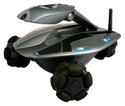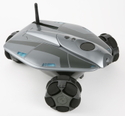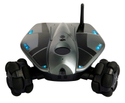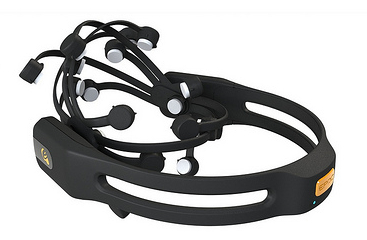First affordable mind-controlled, robotic telepresence?
Last updated Aug 21, 2011 — 816 views
 Software developer Robert Oschler has launched a Kickstarter project aimed at creating a low-cost, mind-controlled, robotic telepresence system, based on integrating support for WowWee’s Rovio robot, Emotiv’s EEG headset, and Skype communications into version 5 of Oschler’s Robodance software.
Software developer Robert Oschler has launched a Kickstarter project aimed at creating a low-cost, mind-controlled, robotic telepresence system, based on integrating support for WowWee’s Rovio robot, Emotiv’s EEG headset, and Skype communications into version 5 of Oschler’s Robodance software.
The core of Robodance 5 will be WowWee’s Rovio telepresence robot, described by Oschler as “an affordable mobile audio and video streaming bot that can be your eyes and ears from anywhere in the world [where] you have a Web connection.”



WowWee’s Rovio mobile telepresence robot
(click thumbnails to enlarge)
“With a versatile 3-wheeled base and adjustable camera you can explore your home or work environment from anywhere in the World, keeping tabs on your home, pets, and loved ones when you are on vacation, or checking in on a warehouse or your company when afar,” adds Oschler.
Although Rovio, as sold by WowWee, already implements robotic telepresence, Oschler says his Robodance 5 software, which initially will run on Windows PCs, will provide several key features not offered by the support software that comes standard with the Rovio robot.
Skyping Rovio
For one thing, Robodance 5’s communications with Rovio will be based on Skype. This, according to Oschler, brings the following benefits:
- No need to expose a port on your router for Web-based access to the Rovio
- No need for setting up (and paying for) a dynamic DNS service for access the Rovio over the Web
- Simplifies the process of establishing a quality two-way remote audio connection
- Provides encryption of video, audio, and login details
Mind control
More importantly, says Oschler, the paid ($49) version of Robodance 5, called “Robodance 5 Pro,” will add the ability for a user to remotely control the Rovio robot using the Emotiv EPOC “neuroheadset” (shown below).

Emotiv’s EPOC “neuroheadset”
This unique headset integrates a built-in gyroscope, plus a “14-channel, high-resolution, neuro-signal acquisition and processing subsystem,” according to Emotiv’s website.
The EPOC headset “allows you to operate a computer in several new innovative ways,” explains Oschler.
“But for Robodance 5 Pro, it is [the headset’s] ability to detect head movement and facial gestures that are important,” Oschler adds. “Coupled with the inexpensive Rovio it can give those with limited mobility a mobile set of eyes and ears to explore their home or any place else in the world there’s a Rovio they can connect to.”
“Where other solutions cost thousands of dollars, the robot, EPOC headset, and Robodance software can be had for a grand total of approximately $600,” says Oschler.
What about people who are unable to move their heads?
“For people [who] do not have head movement capability, I will be adding an alternate interface that uses only the EPOC’s ability to detect subtle muscle tension in the face and scalp and its ability to detect some strong brain activity patterns, without relying on head movement,” Oschler explains. “However, I can’t say that interface will be effective until I have had some real trials with real people.”
Other “Pro” features
In addition to adding Skype communications and supporting Emotiv’s EPOC headset, the Pro version of Robodance 5 also adds these features, according to Oschler:
- Voice control — when at home, you will be able to talk to Rovio’s microphone directly and give it voice commands instead of having to use your PC’s microphone
- Phone on Wheels — when at home, Rovio will let you know when there’s an incoming Skype call; additionally you’ll be able to accept or screen calls using voice commands
- Control via the Nintendo WiiMote (may not work on all systems due to PC WiiMote drivers)
Demonstration video
In the short YouTube video below, Oschler describes and demonstrates his ability to control a Rovio telepresence robot using an EPOC EEG-based headset.
Robodance 5 Kickstarter project
As with all Kickstarter projects, Oschler’s project offers a range of incentives to prospective supporters, depending on the amount of the pledge. Benefits include discounts on the “Pro” version of Robodance 5, extra technical support, and more, contingent on the project reaching or exceeding its funding goal — in this case, $6,800.
In particular, those who pledge $15 or more will be rewarded with a 10- or 20-minute telepresence tour (depending on pledge level), through which they’ll be able to “enjoy the fun and excitement of telepresence robotics without having to own a Rovio robot,” Oschler says.
The telepresence tour “is meant for those people that own or are going to buy an Emotiv EPOC EEG headset and want to see what it is like to drive a Rovio using only facial gestures and head movements before they get one of their own, or just to experience the thrill of mobile telepresence robotics,” explains Oschler. “You will be assigned a time slot when you can dial into one of my Rovio robots and explore my robot room, interacting with some of the crazy robots you saw in my project video.”
“The tour for those who make $15 pledges is similar, but without the EEG headset support,” Oschler adds. “They can download the free version of Robodance when it’s released and can therefore take a telepresence tour at no cost, driving one of my Rovio’s around from their computer. They just can’t do it using the Emotiv EPOC EEG headset, since that requires the Pro version of Robodance and only those who pledge $20 or more get the Pro version. Instead, $15 pledgers will use the free version, which has a standard mouse click driven graphical interface.”
Additionally, if Oschler’s Kickstarter project reaches its funding goal, he’ll be able to release the standard version of Robodance 5 as a free download, available to anyone wanting to use it to communicate with and control a Rovio robot.
Further info
For further details, visit Oschler’s Robodance 5 Kickstarter Project Page.